
![]()
~ ST. JOHN'S HOSPITAL ~
NORTHGATE STREET, CANTERBURY
St. John's Hospital was founded by Archbishop Lanfranc, in 1084, for the lame, weak, and infirm, and contains (with a master and a reader) eighteen in-brothers, (one of whom is annually chosen prior) twenty in-sisters , and the like number of out-brothers and out-sisters (William Gostling)
St. John's Hospital Records available at the Canterbury Cathedral Archives (1358-1962)
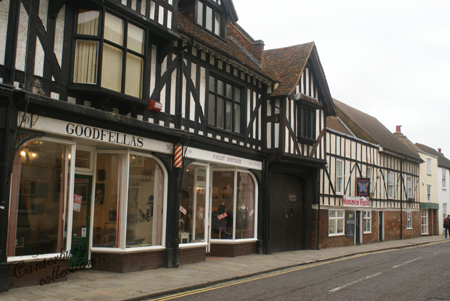
M.S. Accounts of St. John's Hospital, Canterbury, 1511 - 1647, Communicated by Mr. J. M. Cowper
Kent Archaeological Society has monumental inscriptions for St. John's Hospital* on their site (noted by the Rev. Bryan Faussett, 1758) *inside the church only
A special "thank you" to Sydney for the time given to us

_"St. John's Hospital" a detail from one of my old maps

The Gate - from an old glass slide in my collection
The hospital of St. John is situated on the west side of Northgate Street, and is entered by a fine wooden arch, under an interesting house. Eadmer, the disciple of Lanfranc and the writer of his life, dignifies the original building of this house with the name of a palace (palatium), and the ancient walls still remaining inclose a considerable area of ground to the north-west of the present chapel. They are very massive, of rude early Norman masonry, with round-headed doors and windows, only slightly ornamented with the common chevron moulding, coarsely cut. The entrance to the chapel is a doorway of the same style. This chapel which is only a part of the original chapel, has been much altered and modernised. The most remarkable object in the interior is a singularly-shaped early font.
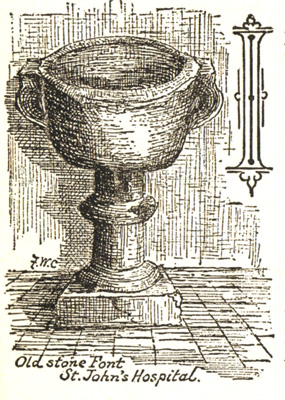
Drawing of the "Old stone font" from Rambles Round Old Canterbury; 1884
In the last century the east window was filled with rich painted glass, representing figures of the twelve apostles, but this has entirely disappeared. The pulpit, and some other wood-work, are good examples of the ornamental carving of the Tudor age. Gostling, our venerable and safe guide to the antiquities of Canterbury, complains bitterly of the unncessary demolition of the old buildings of this establishment perpetrated about the middle of the last century;

"the bells having been sold, the steeple and north isle taken down, as were many of the old houses, and smaller and less convenient ones erected in their room; a stone wall was also taken away, which sheltered the whole from the cold north-west wind blowing over the river and the meadow-land, and being pentised over-head, was called by the poor people their cloisters, under which they used to walk, or sit and converse with each other on benches. All this was done by way of improvement, about thirty years ago." There are still some good specimens of old domestic architecture in the yard, particularly the picturesque group towards the entrance gateway.
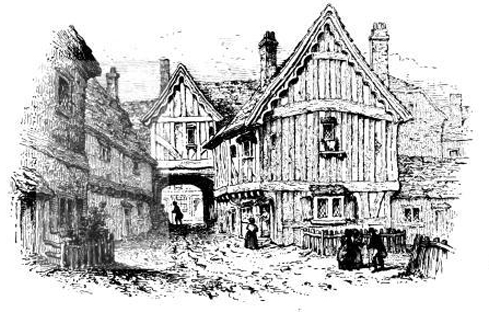
A drawing of St. John's Hospital c. 1845
The kitchen and hall are situated in a building at the south-west corner of the yard or court just mentioned, and appear to be of the end of the sixteenth century.

In the kitchen, which is on the ground floor they shew the ancient spits, from eight to ten feet long. The hall is up stairs, and contains some old furniture, among which the most remarkable is a carved chest and a large sword. A curious old embroidered covering for the table is also shewn. The hall itself is ornamented with the arms of the founders. AA1845
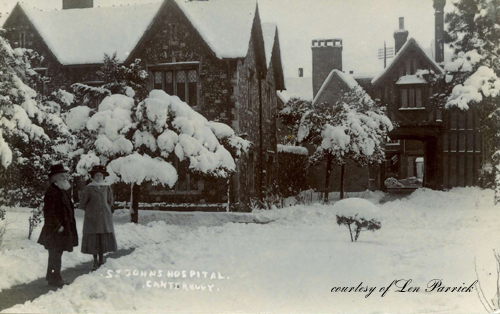
A beautiful postcard of St. John's Hospital in the snow. Thanks kindly to Len Parrick for the above.
The gentleman above with the white beard is Frank Bailey's father and the photo was taken by Frank. Thanks kindly to Mike for this information!
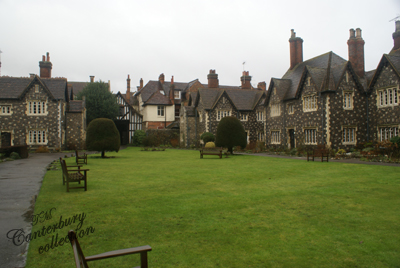
"A GARDEN FETE"
(in aid of Funds for St. Gregory's Parish)
Grounds of St. John's Hospital, Canterbury.
On Thursday, July 25th, 1907, open at 2:30 pm
The Band of the 1st Vol. Batt. East Kent Regiment ("The Buffs'") Champion Band, 35 performers. Aerial Railway. Gymnastics Display by Church Lads' Brigade. Flower Show. Grand Cricket Match; Policemen v. Suffragettes. Entertainment by Children. Band of Church Lads' Brigade.
Presentation of Testimonial to the Rev. A. S. Hope by the Ven. Archdeacon of Maidstone on behalf of the Parishioners of St. Gregory's. "Golden Butterfly" will make frequent trips on the river. Rocking horse, Dancing in the Evening. Refreshments.
Admission: 2 to 4, 1s.: 4 to 6, 6d.; 6 to 9, 3d.
Sidney H. Nelson, Hon. Secretary and Treasurer
\
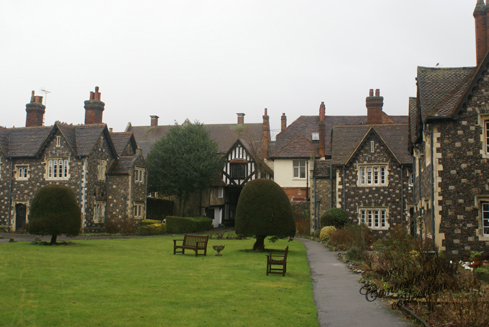
"Wherefore wee ordain and appoint, That, according to the first foundation, there be in our hospital of St. John's in Northgate xxx men, whom (after the ancient custome) wee will to be called bretheren; that by this name they may be the rather put in mind of their duty to live together like bretheren in unity, concord, godly agreement, and brotherly love: and xxx women, whom after the like manner wee will to be called sisters, which all shall be bound to make their abode, and to dwell within our said hospital, except they have for their absence a special grant and dispensation by writing from us or our successors, Archbishops of Canterbury, for the time being. Providing, and allwayes foreseeing, that there dwell not out of the house above the number of x bretheren and x sisters at any time.
Also wee ordain, That upon every vacation or avoydance of any of the rooms of the bretheren or sisters, whither it be by death, deprivation, cession, voluntary departing, expulsion, or by any other lawful means; the Elder or the Prior, so commonly called for the time being, with three of his bretheren, within 10 days next after such avoidance, if the brother dwelt in the house, or in the city of Canterbury, and of others that are further off, (so soone as he or they have certain knowledge thereof,) shall intimate and give in writing unto us and our successors, Archbishops of Canterbury, or else to the Dean and Chapter, (sede vacante,) as well the person's name and manner of departing, as also they day, month, and year of such departing, that wee may eftsones appoint some other to the said roome.
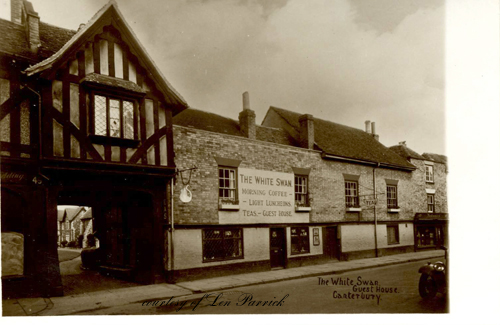
A lovely postcard of St. John's Hospital and The White Swan. Thanks kindly to Len Parrick for the above.
Also we ordain, That henceforth none be admitted brother or sister, but such as shall be named by some certificate from us or our successors under our signet, else shall personally exhibit to the Prior for the time being, and to his bretheren, or unto four of them at the least, a grant of a corrody, under seal from us or our successors, or under the seal of the Dean and Chapter (sede vacante): and the Elder or Prior, upon sight of every such grant, shall, within 2 dayes next following, in the presence of four of his bretheren at the least, admit every such brother and sister without further delay, 'til there be the full number of xxx bretheren and xxx sisters. And every brother and sister, at his or her admission, shall pay towards the maintaining and repairing of the church and other houses, 6s. 8d. and have their names written in the table appointed for the same purpose. And the Prior shall cause these statutes to be read to every brother and sister, at his or her admission to dwell within the hospital; and also to be read yearly on Midsummer-day, before all the bretheren and sisters.
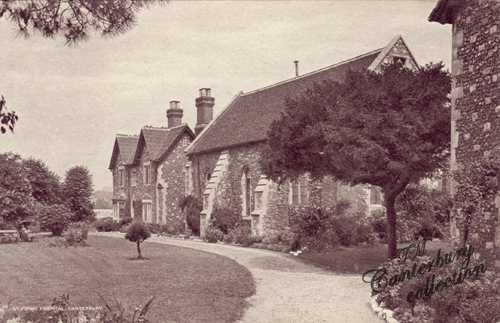
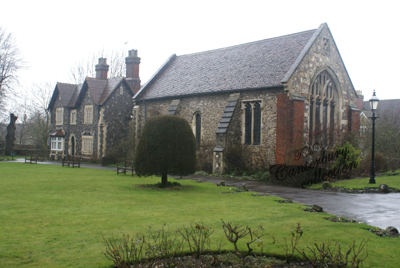
"Nearly all the original buildings have disappeared except the chapel, which has a romanesque-headed doorway. The domiciles are now tenanted by aged men and women, to which they are presented by the Archdeacon. Restorations have been made to the buildings with taste and propriety. A.D. 1507, a complaint was made to the Archdeacon that the Mayor of Canterbury had carried off the ornaments of the chapel and other things, such as a chalice, a paten of silver, suprlices, and the bells. In the chapel were once some stained-glass windows. In one the twelve apostles were portrayed, and there was a memorial to W. Sepvans and his wife." JB
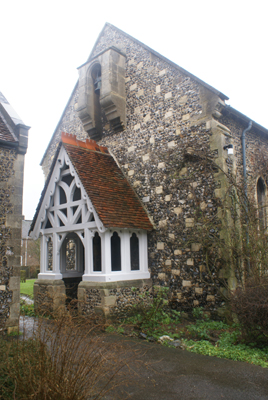
Also wee ordain, That every brother and sister, at his or her admission to dwell in the house, shall take a corporal oath upon a book in manner and form following:
"I, A.B. brother or sister of St. John's in Northgate, shall bear true faith and due allegiance unto the Queen's Highness, her heirs and successors; and shall observe and keep all such statutes and orders and rules which now be, or hereafter may be made and given by Lord Matthew, Archbishop of Canterbury, or by his successors, concerning the state of the hospital, not repugnant to the laws of God, nor to the laws of this realm. And I shall obey the Elder or Prior for the time being, in all things lawfull and honest; and I shall not consent nor agree to sell, to give, to change, to pledge, or by any kind of wayes to alienate any lands, tenements, buildings, pastures, woods, cattle, utensils, stock of money, deeds, charters, or other writings, or any other thing appertaining or belonging to the said hospital, without the consent and assent of said Lord Matthew or his successors, Archbishops of Canterbury, first had and obtained; so God help me, and by the contents of this book."
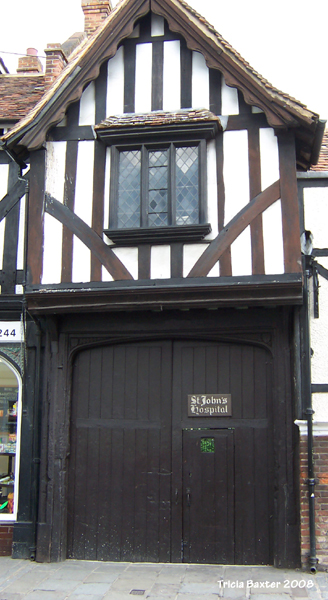
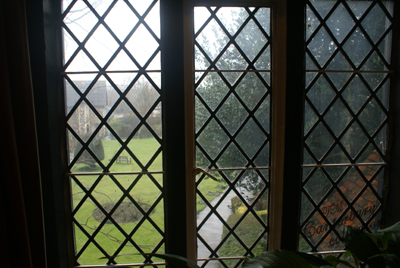
The view out the gatehouse window looking towards the buildings inside
Also we ordain, That none (having the use of reason and speech) be admitted brother or sister, but such as can say the Lord's Prayer, the Articles of Faith, and the X Commandments of God in the English tongue: and that after admission, within a convenient time, they endeavour themselves to learn by heart the brief Catechisme inserted in the Book of Common Prayer.
Also wee ordain, That all the bretheren and sisters dwelling within the said hospital, shall diligently come to the church twice in the day, morning and evening (except there be lawfull cause to be absent, and allowed by the Prior,) there to offer up their common prayers unto Almighty God, and attentively to hear God's holy Scripture read; and if any be absent, (not having sufficient cause,) or be slack and negligent in coming to the church; or being there, do use to jangle, to talk, or to sleep in the time of common prayer, the administration of the sacraments, reading of the holy Scriptures or the Homilyes; if, after two admonitions given by the Prior to amend that fault, the party eftsoones commit the like offense, that brother or sister, whither it be, shall be punished in the stocks one half day or more, at the discretion of the Prior for his or her correction. And if that brother or sister, after such punishment, will not amend, but continue still that lewd behaviour and example, wee will, that the Prior, with the assent of four of his bretheren, do give knowledge unto us, our successors or lawfull deputyes, of the evil qualityes of that brother or sister, that wee, following the example of a good surgeon, may eftsoones cut off that member, which is not only unprofitable, but also hurtfull to the whole body. etc. The Life and Acts of Matthew Parker

An old photo postcard of mine of St. John's Hospital
Opposite to this priory is St. John's hospital, and the church dedicated to St. Gregory is now the chapel* of that hospital, but both have suffered much since Mr. Somner and Mr. Battely described them; the bells having been sold, the steeple and north aisle taken down, as were many of the old houses, and smaller and less convenient ones erected in their room. A stone wall was also taken away, which sheltered the whole from the cold north-west wind blowing over the river and the meadow land, and being pentised over head, was called by the poor people their cloisters, under which they used to walk, or sit and converse with each other on the benches. All this was done by way of improvement, about eighty years ago, (in 1747). William Gostling 1825
*In this chapel were the remains of a very fine window of painted glass, said to have been given by John Roper, gent. but they have been lately removed and sold.
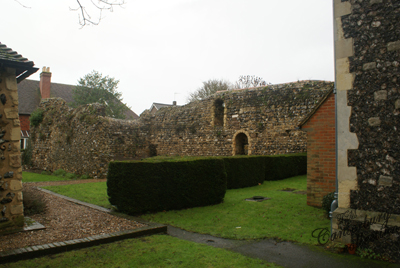
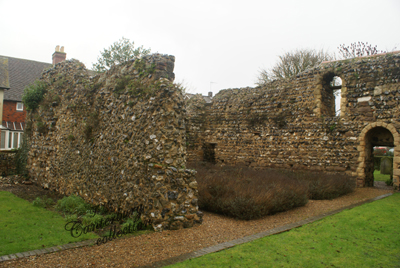
A lavender garden
"John Rooper, Gent. dwelling in the Hospital of St. John without the walls of Canterbury. I will that there be made as large a window at Our Lady's altar of the said Hospital as there now is at the high altar of the said Hospital, to be glazed within two years after my decease, with such imagery or pictures as I shall show to my executors. Thomasine, my wife; Sir William Braborne, Prior of St. Gregory; Master Wootton; William Brent, Gent.; my lands in Wyngham, Staple, and Goodnestone, purchased of William Broke, and in Westbere and Chistlet, purchased of Overton; Alys Wode, my grandmother; William Tucke, my grandfather; my lands in Boughton, purchased of Richard Potman; Johanna, my daughter. My manor of Hawe in St. Stephen's of Hackington, and a court-lodge and dove-house in St. Dunstan's, &c. to the use of me and my wife in tail male; remainder to our right heirs; remainder to my wife, and her heirs in fee. I will that my manors, lands, &c. in Whitstaple, Costonus, Bleane, Sturrey, and Bekesborne, late belonging to William Woodland, my grandfather*, and which Alys Woode, daughter of the said William, my grandmother, devised to me by her will, shall remain to Thomasine, my wife, for life, and afterwards to the heirs of my body in tail male; remainder to the heirs general of my body, &c. My manor of Brendley, in Boughton, with its appurtenances, in like manner. Sir Dunstan Petle, Vicar of Westgate, Canterbury; Benet, my sister, wife of Richard Ramsay. Proved at Canterbury, 12th October, 1527." Testamenta Vetusta 1826 *Query, Great-Grandfather: Vide infra.
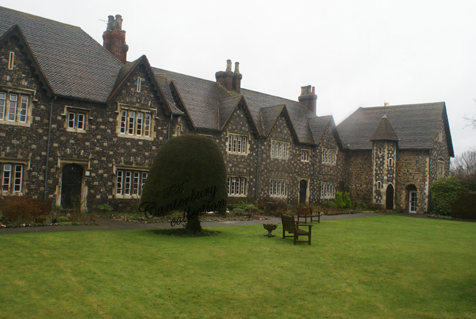
Showing the building that holds the refectory and old kitchen at the end on the far right with the stair tower
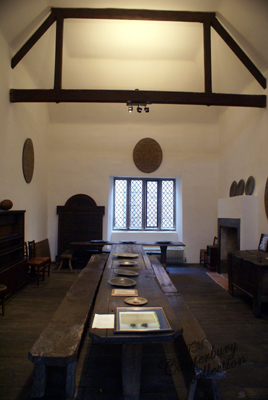 __
__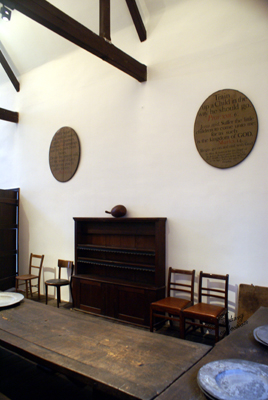
St. John's Hospital, The Refectory
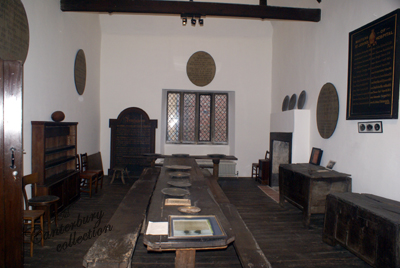
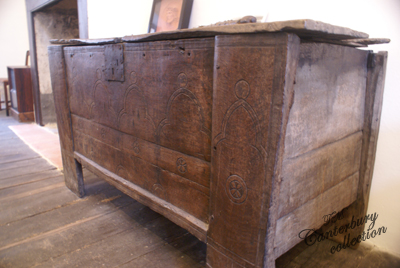 _
_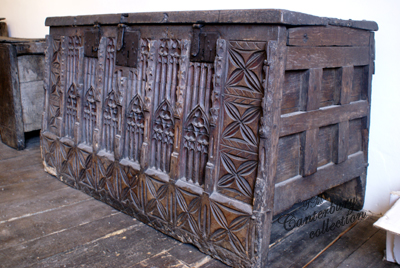
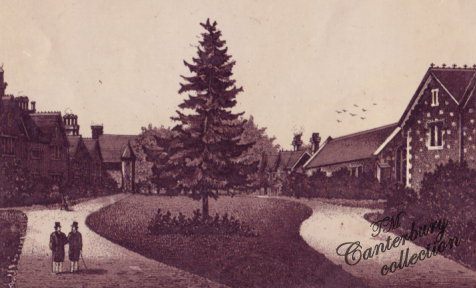
Drawing from "The Album of Canterbury Views", Charles Reynolds & Co., London c. 1890's
"St. John's Hospital, without the Northgate, was founded in 1084 by Archbishop Lanfranc, who endowed it with £70 per annum for poor infirm, lame, and blind men and women; at the time of the dissolution its revenue was £93. 15., and it is now nearly £200; the establishment consists of a prior, reader, fifteen brothers, and fifteen sisters resident, who receive each £8 per annum, with a share of some legacies left in trust to the corporation; and three brothers and sisters non-resident, who receive something less, and do not participate in the legacies; the archbishop has the exclusive patronage and appoints the master and prior."
From the 1831 Topographical Dictionary
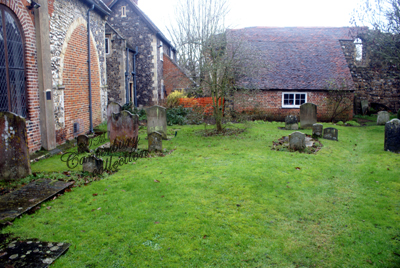
Died at Canterbury (March), Mrs. DODSON, one of the sisters of St. John's Hospital, 81. The Monthly Magazine 1807 pg. 198
*burial January 30, 1807 Mary Dodson from St. John's Hospital, in ye Cloyster Yard. Aged 82. (Canterbury Cathedral)
Died at Canterbury (October), 68, Mrs. Elizabeth ASHMAN, one of the sisters of St. John. The Monthly Magazine 1813 pg. 282
June 1815, died at Canterbury, Mr. RIQUEBOURGH, one of the brothers of St. John's Hospital. Mr. John SNELLING, another brother of St. John's Hospital. TMM 1815
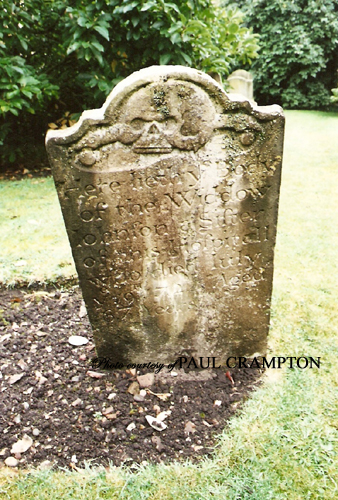
"Here lieth ye body of the Widdow Johnson, as sister of this hospital, who died July 19th, 1724 aged 67 years."
St. John's Hospital Cemetery (work in progress)
Burials in Canterbury Cathedral Cloisters
August 13, 1721 Ellen, the wife of Henry Smith & a sister of St. John's Hospital in the Cloyster Yard
December 14, 1794 Sarah Halsey (from St. John's Hospital) in the Cloyster Yard
December 2, 1813 George Le-gassick, of St. John's Hospital, Northgate. Aged 73 Years
"The hospital of St. John the Baptist and the remains of St. Gregory's Priory are in Northgate street; both were founded by Archbishop Lanfranc, the former in 1084, and the latter, c. 1074, for canons regular of the order of St. Augustine: in the chapel of St. John's Hospital is an ancient font, a carved pulpit and other good woodwork, and in the hall an old carved chest; the precincts exhibit some good examples of Domestic Gothic: here are maintained twenty-five brothers and sisters; the Rev. Francis Robert Mercer M.A. vicar of St. Gregory's has been chaplain since 1901; the stipend is 30 pounds per annum; Canon Francis James Holland M.A. is prior, and has the nomination of the inmates." From Kelly's 1903 directory of Kent
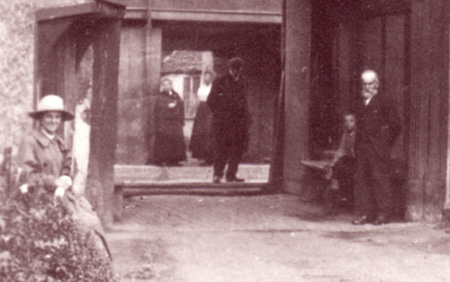 |
__"St. John's Hospital" detail of the gateway from one of my old cards (not postally used)
"St. John's Hospital near Northgate, for diseased men and women, owns the same founder as St. Nicholas at Herbaldown*, Archbishop Lanfranc, in A.D. 1084. The Romanesque or semicircular headed doorway of the chapel is remaining, besides two or three small old arches. The ruins shew it to have been much greater than it now is. The old spits, from eight to ten feet long, are still in the kitchen. The "quire" window is mentioned by Somner, "as a very brave window, having in so many panes, every of the twelve apostles portrayed, with the several articles of the creed that they are said to make," but nothing remains of it."
*yes, it's spelt like this in the book
Felix Summerly's "Handbook for the city of Canterbury", 1843
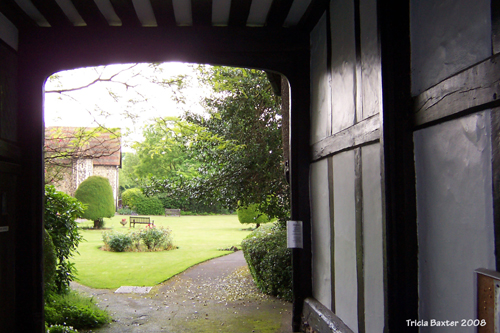
A view inside the gateway, the buildings are not open for visitors
The canons had the duty of ministering to the infirm in the Hospital of St. John, opposite, also founded by Lanfranc, and the twin hospital of Harbledown. More than 100 poor were sustained in this hospital and adjoining edifices, temp. Edw. III. (Somner). In the chapel was a "very brave quire window, with the 12 Apostles," given by one of the Roper family, of which only fragments remain. The hospital has been recently restored. The most interesting part remaining is the Gateway, a wooden structure, arched. A handbook for Travellers in Kent and Sussex 1858
John Bexley was a resident of the hospital of St. John in Canterbury, sometime after his retirement in 1780 *from John Bexley, Fifty-four years the Canterbury News Carrier. published July 1st, 1788
"The Hospital of St. John, and the remains of St. Gregory's Priory, are in Northgate-street; both were founded by Archbishop Lanfranc in 1084. In the Chapel of St. John's is some fine painted glass. Here are maintained a prior and 18 bothers and sisters, nominated by the Archbishop; they form a precinct." 1858 Directory, Melville & Co.
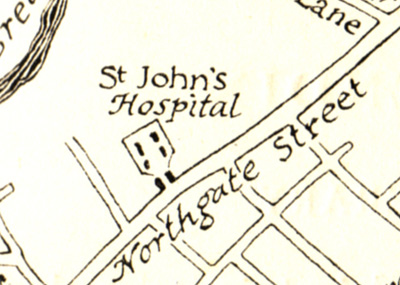
1889
Block No. 1
Henry Driver, Mrs. Taylor, J. Welch, J. Lines
Block No. 2
Hy. Rising, Miss Bailey, Mrs. Dalrymple, George Hayward
Block No. 3
Mrs. M. Steed, J. Hookway, Mrs. Summerford, Mrs. Eastes
Block No. 4
J. Groom, Mrs. Sands, G. Blair, Mrs. Barnett
Block No. 5.
Mrs. Joiner, Mrs. Webster, Henry Petman, J. Downs
Block No. 6
Hy. Duncan, Mrs. Emery, J. White, Miss Muffett, Rev. Gibbons, chaplain of church and hospital
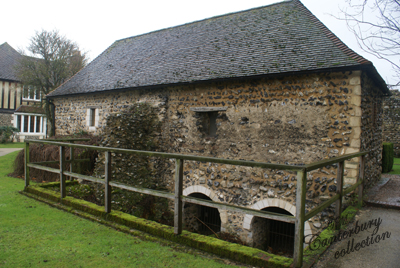
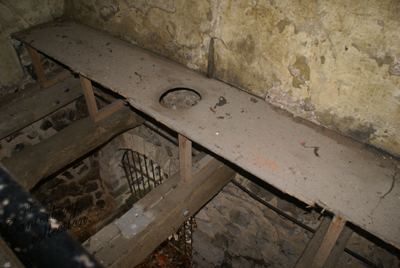 __
__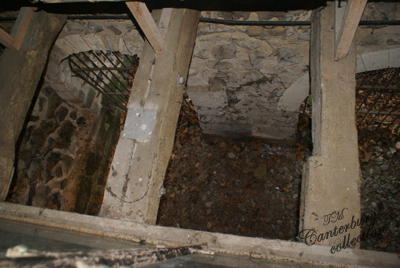
Previous brothers & sisters
George Culmer - 1809
George Le-Gassick (buried in Canterbury Cathedral Cloisters, see above)
Edward & Mary Castle
Edward and Mary Sheeter
Amy A. William
Jane Hayward
William and Maria Beckett
Stephen Hudson
John L. & Emma Bedingfield *sub prior
Sarah Savage
Charlotte Eastes
John William & Alice Potter
Lilla J. Knight
Mary A. Brown
George & Jane Blair
Jane Joiner
Sarah Manver
Mary A. Wratton
Charlotte Jordan
William Luckett
William & Mary A. Fagg
George CASTLE
Virginia Norton
A Book Entitled: "The History and Antiquities of the Three Archiepiscopal Hospitals at and near Canterbury; viz. St. Nicholas, at Harbledown; St. John's, Northgate; and St. Thomas, of Eastbridge; with some Account of the Priory of St. Gregory, the Nunnery of St. Sepulchre, the Hospitals of St. James and St. Lawrence, and Maynard's Spittle. By John Duncomb, M.A., Vicar of Herne, and Master of the Hospitals of St. Nicholas and St. John; and the late Nicholas Battely, M.A. Vicar of Beaksbourn, and Editor of Somner's Antiquities of Canterbury." "...Juvat antiquos accedere fontes, Atque haurire......." London, printed by and for J. Nichols. MDCCLXXXV. Plates, W. View of St. Nicholas Hospital, Harbledown. Arthur Nelson del. 1766, 2 - Curious Maple Bown at Mapledown, W. View of St. John's Hospital, Canterbury, J. Raymond, del. 1784, Seals of Harbledown and St. John's Hospital. N. View of Eastbridge Hospital, Canterbury, taken from King's Mill, Raymond del. Cook sc. South View of Kingsbridge and Mill, and of the Church of All Saints at Canterbury, according to the late improvements taken (from the Parlour Window of the King's Head Inn), March 11, 1780. J. Pridden del. Seals of Eastbridge Hospital, &c. View of St. Gregory's Priory, Canterbury. Ruins of St. Thomas's Chapel, Canterbury, as they appeared in 1781. F. Perry del. W. View of St. Sepulchre's Nunnery, and N.E. View of Maynard's Spital, Canterbury. W. Groombridge del. 1785. Seals of St. Gregory's Priory, St. Maynard's Spital, &c.
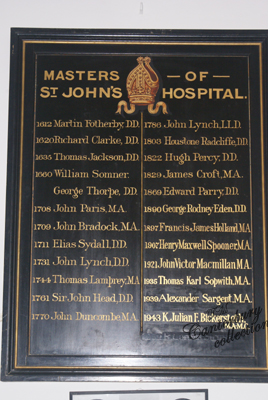
In 1660 Somner was made master of St. John's Hospital, in the suburbs of Canterbury, and about the same time auditor of Christ Church. In this year he published in quartro his "Treatise on Gavelkind," his last publication. He died March 30th, 1669.
John Duncombe, son of William Duncombe (English writer), was born in 1730. He was educated at private schools at Romford and Felsted, where he displayed great regularity, uncommon application, and superior talents. At the age of 16 he was admitted at Benet's college, Cambridge, at the recommendation of archbishop Herring his fathers friend. In 1750 he was chose fellow of his college, and three years after took orders, and became assistant preacher at St. Anne's Soho, where his eloquence as an orator, and his amiable manners in private life, gained him the respect of a populous neighborhood. In 1757, the primate Herring gave him the livings of St. Andrew and St. Mary Bredman, Canterbury, but the death of that excellent patron, two months after, cut off all hopes of further and more valuable preferment. He married in 1763, the daughter of Mr. Highmore the painter, with whom he enjoyed 23 years of uninterrupted domestic happiness. In 1766, Seeker appointed him one of the six Canterbury preachers, and the next primate, Cornwallis, presented him, in 1773, to the living of Herne, six miles from Canterbury. He was also master of Harbledown and St. John's Hospitals, which, though places of trust and not emolument, enabled him to display his regard for the poor, and his humane endeavours to relieve their necessities. He was also an active magistrate, and in this office he was the means of encouraging virtue and of checking vice. He was attacked by a paralytic stroke 21st June 1785, from which he never recovered, and died on the 18th of the following January. He left only one daughter. His works are chiefly fugitive pieces published in Dodsley's collection, and in periodical magazines, besides the Semincad, and a poem on the death of Frederick prince of Wales. He also greatly assisted his father in his translation of Horace, and published the seventh satire of the second book in 1752, imitated, and inscribed to R. Owen, Cambridge. Universal Biography 1810
1889 - Rev. Gibbons, chaplain of church and hospital
1903 - Rev. Francis Robt. Mercer M.A. chaplain; Canon Francis James Holland M.A. prior & master
© T. Machado 2007